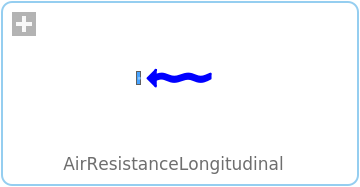WOLFRAM SYSTEM MODELER
AirResistanceLongitudinalVelocity dependent longitudinal air resistance |
|
Wolfram Language
SystemModel["PlanarMechanics.VehicleComponents.AirResistanceLongitudinal"]

Information
The vehicle's air drag, resolved in frame_a, is calculated as:
fDrag = ( c_W * area * rho * v_x^2 ) / 2
where:
c_W : air drag coefficient, area : cross area of vehicle, rho : density of the air, v_x = vAir[1] : longitudinal component of air velocity, resolved in frame_a.
Just air drag in vehicle's longitudinal direction is calculated here,
which can be specified for frame_a.phi = 0 by the
parameter r.
For example for r = {1, 0} the driving direction is in
x-direction of frame_a and, thus, frame_a.fx = fDrag.
The other forces and torque are disregarded.
Note
This model is limited to negative air velocity v_x only.
For positive velocity, which can occur e.g. when driving rearwards,
the air drag is set to zero.
Parameters (4)
Connectors (1)
| frame_a |
Type: Frame_a Description: Coordinate system (2-dim.) fixed to the component with one cut-force and cut-torque (blue icon) |
|---|
Used in Examples (2)
|
PlanarMechanics.VehicleComponents.Examples Test air drag model |
|
|
PlanarMechanics.VehicleComponents.Examples Single track model |
Revisions
 Developed 2022 at the DLR Institute of System Dynamics and Control
Developed 2022 at the DLR Institute of System Dynamics and Control
